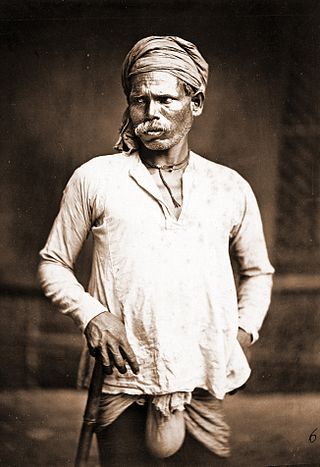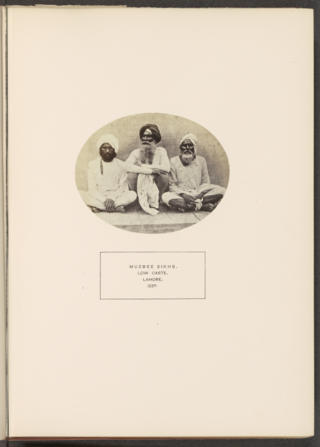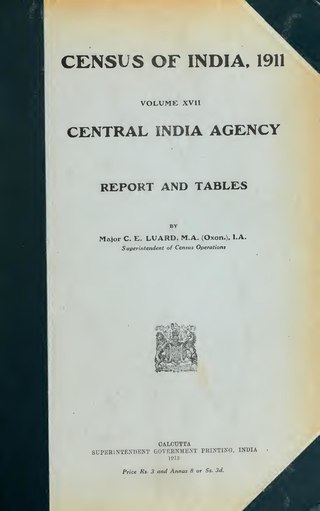
India is the most populous country in the world with one-sixth of the world's population. According to estimates from the United Nations (UN), India has overtaken China as the country with the largest population in the world, with a population of 1,425,775,850 at the end of April 2023.

Prasanta Chandra Mahalanobis OBE, FNA, FASc, FRS was an Indian scientist and statistician. He is best remembered for the Mahalanobis distance, a statistical measure, and for being one of the members of the first Planning Commission of free India. He made pioneering studies in anthropometry in India. He founded the Indian Statistical Institute, and contributed to the design of large-scale sample surveys. For his contributions, Mahalanobis has been considered the Father of statistics in India.

The Dom, also known as Domra, Domba, Domaka, Dombara and Dombari, are castes, or groups, scattered across India. Dom were a caste of drummer. According to Tantra scriptures, the Dom were engaged in the occupations of singing and playing music. Historically, they were considered an untouchable caste called the Dalits and their traditional occupation was the disposal and cremation of dead bodies. They are in the list of Scheduled caste for Reservation in India in the Indian states of Uttar Pradesh, Bihar, Odisha, Andhra Pradesh, Jharkhand and West Bengal.

Indian Statistical Institute (ISI) is a public research university headquartered in Kolkata, West Bengal, India. It was declared an Institute of National Importance by the Government of India under the Indian Statistical Institute Act, 1959. Established in 1931, it functions under the Ministry of Statistics and Programme Implementation of the Government of India.

Kheda District was also known as Kaira District in British Raj. Kheda District one of the thirty-three districts of Gujarat state in western India. It is part of the region known as Charotar, consisting of Kheda and Anand districts. Kheda was Former Administrative Capital In British Raj. Now Nadiad is the administrative headquarters of the district.

Firozpur district, also known as Ferozepur district, is one of the twenty-three districts in the state of Punjab, India. Firozpur district comprises an area of 2,190 km2 (850 sq mi).
The decennialcensus of India has been conducted 15 times, as of 2011. While it has been undertaken every 10 years, beginning in 1872 under Viceroy Lord Mayo, the first complete census was taken in 1872. Post 1949, it has been conducted by the Registrar General and Census Commissioner of India under the Ministry of Home Affairs, Government of India. All the censuses since 1951 were conducted under the 1948 Census of India Act, which predates the Constitution of India. The 1948 Census of India Act does not bind the Union Government to conduct the census on a particular date or to release its data in a notified period. The last census was held in 2011, whilst the next was to be held in 2021 before it was postponed due to the COVID-19 pandemic in India. The next census is yet to have a confirmed date.

Mazhabi Sikh is a community from Northern India, especially Punjab region, who follow Sikhism. Mazhabi are part of wider category of Sikhs, who convert from the valmiki (chuhra) community. The word Mazhabi is derived from the Arabic term mazhab, and can be translated as the faithful. They live mainly in Indian Punjab, Rajasthan and Haryana.

Sir Herbert Hope Risley was a British ethnographer and colonial administrator, a member of the Indian Civil Service who conducted extensive studies on the tribes and castes of the Bengal Presidency. He is notable for the formal identification of the centuries old established caste system of the entire Hindu population of British India in the 1901 census, of which he was in charge. As an exponent of scientific racism, he used anthropometric data to divide Indians into seven races.

Sir Denzil Charles Jelf IbbetsonKCSI was an administrator in British India and an author. He served as Chief-Commissioner of the Central Provinces and Berar from 1898 to 1899 and Lieutenant-Governor of Punjab in 1907.

The 2011 census of India or the 15th Indian census was conducted in two phases, house listing and population enumeration. The House listing phase began on 1 April 2010 and involved the collection of information about all buildings. Information for National Population Register (NPR) was also collected in the first phase, which will be used to issue a 12-digit unique identification number to all registered Indian residents by Unique Identification Authority of India. The second population enumeration phase was conducted between 9 and 28 February 2011. Census has been conducted in India since 1872 and 2011 marks the first time biometric information was collected. According to the provisional reports released on 31 March 2011, the Indian population increased to 1.21 billion with a decadal growth of 17.70%. Adult literacy rate increased to 74.04% with a decadal growth of 9.21%. The motto of the census was Our Census, Our Future.
Sir Jervoise Athelstane Baines was an administrator in the Indian Civil Service during the period of the British Raj.
Koregaon Bhima is a panchayat village and census town in the state of Maharashtra, India, on the left (north) bank of the Bhima River. Administratively, Koregaon Bhima is under Shirur Taluka of Pune District in Maharashtra. There is only the single town of Koregaon Bhima in the Koregaon Bhima gram panchayat. The town of Koregaon Bhima is 10 km along the SH 60 motorway southwest of the village of Shikrapur, and 28 km by road northeast of the city of Pune. It is the site of the Battle of Koregaon fought on 1 January 1818.
John Henry Hutton CIE FRAI was an English-born anthropologist and an administrator in the Indian Civil Service (ICS) during the period of the British Raj. The period that he spent with the ICS in Assam evoked an interest in tribal cultures of that region that was of seminal importance. His research work was recognised subsequently with his appointment to the chair of William Wyse Professor of Social Anthropology at the University of Cambridge and with various honours.
William Walter Murray Yeatts was Census Commissioner for the 1941 census of India, which was the last such exercise prior to the country's independence from the British Raj. He was appointed to the same office for the 1951 census, having elected to stay in the country, but died before it took place.

Census in British India refers to the census of India prior to independence which was conducted periodically from 1865 to 1941. The censuses were primarily concerned with administration and faced numerous problems in their design and conduct ranging from the absence of house numbering in hamlets to cultural objections on various grounds to dangers posed by wild animals to census personnel. The sociologist Michael Mann called the census exercise "more telling of the administrative needs of the British than of the social reality for the people of British India". The differences in the nature of Indian society during the British Raj from the value system and the societies of the West were highlighted by the inclusion of "caste", "religion", "profession" and "age" in the data to be collected, as the collection and analysis of that information had a considerable impact on the structure and politics of Indian society.
The Socio Economic and Caste Census 2011 (SECC) was conducted for the 2011 Census of India. The Manmohan Singh government approved the Socio Economic and Caste Census 2011 to be carried out after discussion in both houses of Parliament in 2010. SECC-2011 was not done under the 1948 Census of India Act and the Registrar General and Census Commissioner of India was not entrusted to do the same. The SECC 2011 was conducted in all states and union territories of India and the first findings were revealed on 3 July 2015 by Union Finance Minister Arun Jaitley. SECC 2011 is also the first paperless census in India conducted on hand-held electronic devices by the government in 640 districts. The rural development ministry has taken a decision to use the SECC data in all its programmes such as MGNREGA, National Food Security Act, and the Deen Dayal Upadhyaya Grameen Kaushalya Yojana. SECC 2011 was the first caste-based census since 1931 Census of India, and it was launched on 29 June 2011 from the Sankhola village of Hazemara block in West Tripura district.

Charkhi Dadri District is one of the 22 districts of Haryana state in north west India near Rajasthan border, but not sharing border with Rajasthan. Created on 1 December 2016, the district headquarters is the city of Charkhi Dadri.

The 2025 census of India, or the 16th Indian census, is to be conducted in two phases, a house listing phase and a population enumeration phase. Although initially the house listing was to begin in April 2020 along with the updating of the National Population Register, and the population enumeration on 9 February 2021, they have been continuously postponed. Initially the house listing was to be conducted between April and September 2020, with population enumeration in February 2021 and a revision round in March 2021. The reference date was to be 1 March 2021 in most of the states and 1 October 2020 for Jammu and Kashmir and some areas of Himachal Pradesh and Uttarakhand. On 2 January 2023, Additional Registrar General of India communicated to all the states that the date of freezing of administrative boundaries had been extended till 30 June 2023. The 16th census can only begin three months after the administrative boundaries have been frozen. The completion of the census in its two phases takes at least 11 months, so the possibility of the completion of this decennial census exercise in 2024 or early 2025 is ruled out, as the census was expected to begin in September 2024, but due to unexplained reasons, had still not started by early October 2024. It was reported that month that the census would take place in 2025, with a decision on a caste census still not decided. It will also serve the purpose of redistibuting seats in the Lok Sabha for the 2029 national election.














